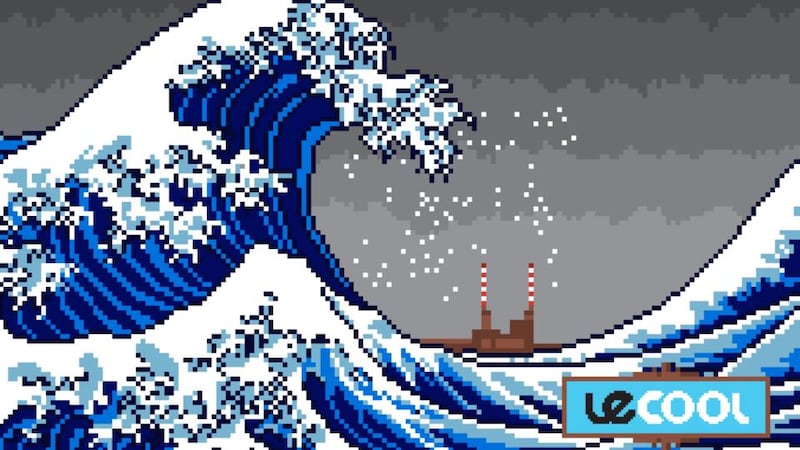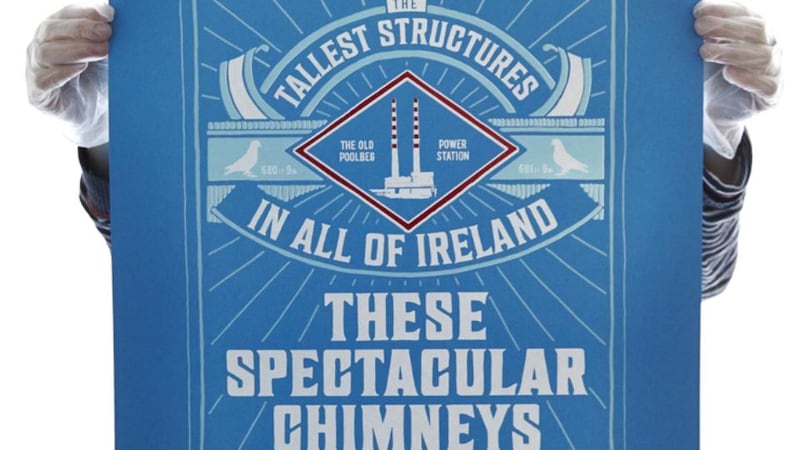'It was too late and we were too tired to carry out our project of visiting the Pigeon House. We had to be home before four o'clock lest our adventure should be discovered. Mahony looked regretfully at his catapult and I had to suggest going home by train before he regained any cheerfulness. The sun went in behind some clouds and left us to our jaded thoughts and the crumbs of our provisions." In James Joyce's An Encounter, the narrator and his friend Mahony never get to the Pigeon House, the power station at Poolbeg, but plenty of other artists have made it there, taking the smoke stacks as visual inspiration.
The Pigeon House chimneys are increasingly finding their way into prints, photographs, paintings and textiles. And as the threat of demolition hangs over the Poolbeg power station, their popularity appears to be increasing, perhaps spurred on by their newfound artistic representations. Their increased visibility can also be put down to an upsurge in the number of people making Dublin-specific art. In the past five years, Dublin-centric merchandise, prints and textiles have moved beyond the tacky knick-knacks to cool and beautiful pieces of design.
The print boom


The Cake Cafe's aprons by Niall Sweeney; Fatti Burke's gorgeously simple piece When I Die Dublin Will Be Written in My Heart; Flax Fox's Trinity College and Merrion Square tea towels; Shane O’Connor's drawings of buildings; and an endless stream of Dublin-themed tote bags all represent a boom in affordable Dublin art.
Shops stocking well-priced contemporary art such as Jam Art Factory, Designist, the Irish Design Store and others, have also facilitated the popularity.
Mark Haybyrne is one of the people behind Jam Art Factory, which has two shops, one on Patrick Street and another in Temple Bar. "We are always getting new designs in inspired by the Pigeon House," says Haybryne. "We've got a laser-cut piece by Snow, a carbon-print photo by Dominique Beyens and we'll soon be getting a piece in done in pixel-art style by Shane Gavin.
"Each one is completely different. The laser cut by Snow is very simple and clean-cut and uses only red and white. Dominique Beyens's photo is very atmospheric and printed in black and white, and Shane Gavin's pixel piece is very cartoony and has a bit of humour in it as it's a parody of the Japanese woodblock print The Great Wave off Kanagawa."
Haybyrne has noticed an increase in the Pigeon House’s popularity over the past year. “We get a lot of Irish people coming in and buying the Dublin-inspired pieces for their friends and family who have emigrated over the last few years. We also get a lot of people who have emigrated and come back to visit family and friends who want to bring something back with them that reminds them of Dublin. They tell us how much they cling on to their Irishness when abroad and they miss the little things that you take for granted when you’re in Dublin every day. One of those things would be being able to see the Poolbeg towers from so many different places throughout the county.”
Le Cool Dublin, an events guide published and emailed to subscribers every week, is generally ahead of the curve when it comes to reflecting what's going on in the city, as well as running its own events. It also contributes to the city's artistic interpretation, commissioning a different cover by a different artist every week that reflects "some positive aspect of Dublin living", says Ciaran Walsh, its managing editor. "It's amazing how many people focus on the towers, though," he says. "I guess it's because of their simple and beautiful graphic aesthetic; they are like huge candy canes. They are visible from all over Dublin, and Dubliners obviously have a great affinity with them, unlike the Spire, for example. They haven't been imposed on people, and they hold a sense of functionality. I wonder is it because of a dearth of any other iconic buildings/ architecture? Or is it because Dublin is such a low city? We've always built out, not up, so the towers do dominate the skyline."
That Annie Atkins print
One of the most striking representations of the Pigeon House is a new print by Annie Atkins, who has been drawn to the towers since she was a child visiting from Wales, She moved to Dublin seven years ago.
“I get that they’re an eyesore. But it doesn’t matter how ugly you think they are, they’re so photogenic,” she says. “They’re a duo, and who doesn’t like red and white stripes? I think a lot of it is to do with silhouetting. Even without stripes you can recognise them. At first they look like identical towers, but they’re not. One is a foot shorter, one is skinnier, they look like one is a bit farther away. And they have the light at the top which makes them feel like a lighthouse.”
Last week, the ESB raised a red flag in relation to Poolbeg Generating Station. Structural and repair works are needed, and the towers could also do with a paint job. The ESB has questioned whether spending money on protecting a structure that’s no longer used is the best use of resources.
And then there is Dún Laoghaire-based designer Michael Ó Mara’s radical proposal to transform the redundant chimney stacks into a major tourist attraction by wrapping them in spiral ramps and creating a “sky bridge” between the two towers.
Whatever happens, Pigeon House’s increasing popularity, born out of nostalgia, familiarity, an appreciation of industrial design and perhaps also the structure’s new visibility in art, has won it fans, as a shift occurs in many people’s attitudes from seeing it as a blight to something worth keeping.
“I don’t think they’re going to disappear,” says Atkins. “I think they’ll continue to show up in art work for years, certainly in illustration and design. They’ll be immortalised.”













